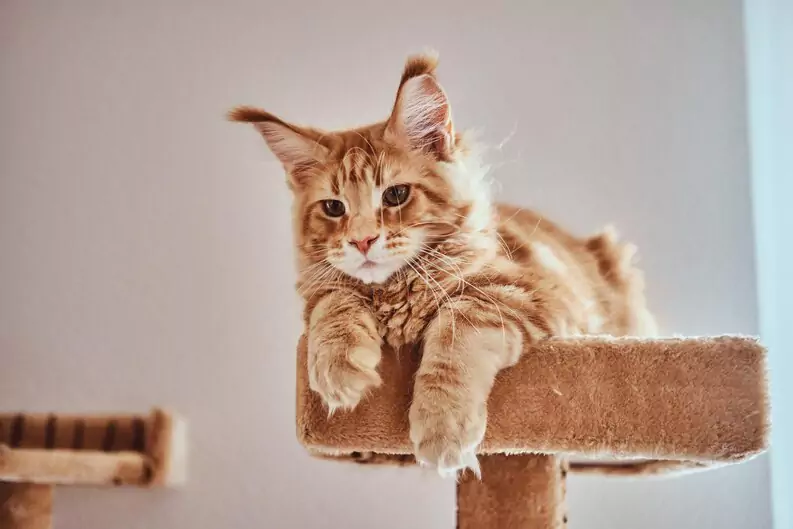Cats, known for their mysterious and independent nature, can sometimes exhibit perplexing behaviors that leave their owners scratching their heads. One such behavior that can be both frustrating and puzzling is when a cat decides to use your clothes as an alternative bathroom. In this article, we’ll delve into the potential reasons behind why Cats pee on clothes and explore effective solutions to address and prevent it.

Understanding the Cat’s Perspective
1. Territorial Marking:
- Natural Instincts: Cats are territorial creatures, and one way they mark their territory is through scent marking. Your clothes, with your scent, may become a target for this instinctual behavior.
2. Medical Issues:
- Underlying Health Problems: Cats may resort to inappropriate urination when they’re experiencing health issues like urinary tract infections, kidney problems, or diabetes. If your cat suddenly changes its elimination habits, a visit to the vet is crucial.
3. Stress and Anxiety:
- Emotional Triggers: Cats are sensitive to changes in their environment. Stressors like new pets, changes in routine, or unfamiliar scents can induce anxiety, leading to inappropriate urination.
4. Litter Box Preferences:
- Picky Habits: Cats can be particular about their litter box preferences. If the litter is not to their liking or the box is not kept clean, they may seek alternative places to relieve themselves.
5. Attention-Seeking Behavior:
- Expressing Discontent: Cats may use urination on clothes as a way to gain attention, especially if they feel neglected or if there have been recent changes in the household dynamics.
Addressing the Issue
1. Veterinary Consultation:
- Rule Out Health Issues: If your cat is displaying unusual elimination behavior, it’s crucial to consult a veterinarian. Medical issues should be ruled out or addressed as a priority.
2. Litter Box Maintenance:
- Cleanliness Matters: Ensure the litter box is kept clean, scooping it daily and providing a litter type that your cat prefers. Some cats are sensitive to scented litters, so opt for unscented varieties.
3. Creating a Calm Environment:
- Minimize Stressors: Identify and minimize stressors in your cat’s environment. Providing a secure and comforting space with familiar items, like blankets or toys, can help alleviate anxiety.
4. Quality Time and Attention:
- Reinforce Bonds: Spend quality time with your cat, offering affection and engaging in play. Strengthening the bond between you and your cat can reduce attention-seeking behaviors.
5. Positive Reinforcement:
- Encourage Good Behavior: Use positive reinforcement to encourage proper litter box use. Reward your cat when they use the litter box appropriately, reinforcing the behavior you want to see.
6. Anti-Anxiety Measures:
- Use of Pheromones: Consider using pheromone diffusers or sprays designed to reduce stress in cats. These mimic natural feline facial pheromones, creating a sense of security.
7. Environmental Enrichment:
- Stimulating Activities: Provide your cat with stimulating toys and activities to keep them mentally and physically engaged. This can reduce boredom and contribute to a more contented feline.
Preventing Future Incidents
1. Regular Veterinary Check-ups:
- Proactive Healthcare: Schedule regular veterinary check-ups to monitor your cat’s health and address any emerging issues promptly.
2. Consistent Routine:
- Maintain Stability: Cats thrive on routine, so try to keep feeding times, play sessions, and other activities consistent to provide a stable environment.
3. Multiple Litter Boxes:
- Accommodate Preferences: If you have multiple cats, provide enough litter boxes to avoid competition. Some cats prefer separate areas for elimination.
4. Hygiene and Cleanliness:
- Thorough Cleaning: Clean any soiled areas thoroughly to remove scent marks that might attract a cat back to the same spot.
5. Open Communication with Vet:
- Behavioral Concerns: Keep your veterinarian informed about any behavioral changes in your cat, ensuring they are aware of the cat’s overall well-being.
In conclusion, decoding why your cat may be peeing on your clothes requires a careful examination of their environment and health. By addressing potential medical issues, creating a stress-free environment, and using positive reinforcement, you can foster a healthier relationship with your feline companion. Patience, understanding, and a proactive approach are key elements in resolving and preventing inappropriate urination behaviors in your beloved cat.

